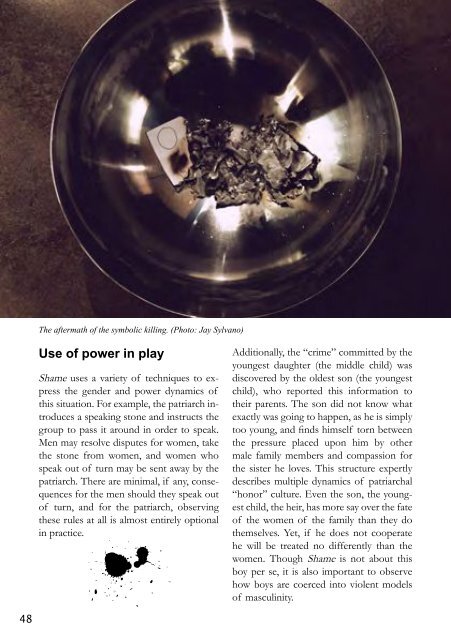nordiclarpyearbook2015
nordiclarpyearbook2015
nordiclarpyearbook2015
You also want an ePaper? Increase the reach of your titles
YUMPU automatically turns print PDFs into web optimized ePapers that Google loves.
The aftermath of the symbolic killing. (Photo: Jay Sylvano)<br />
Use of power in play<br />
Shame uses a variety of techniques to express<br />
the gender and power dynamics of<br />
this situation. For example, the patriarch introduces<br />
a speaking stone and instructs the<br />
group to pass it around in order to speak.<br />
Men may resolve disputes for women, take<br />
the stone from women, and women who<br />
speak out of turn may be sent away by the<br />
patriarch. There are minimal, if any, consequences<br />
for the men should they speak out<br />
of turn, and for the patriarch, observing<br />
these rules at all is almost entirely optional<br />
in practice.<br />
w<br />
Additionally, the “crime” committed by the<br />
youngest daughter (the middle child) was<br />
discovered by the oldest son (the youngest<br />
child), who reported this information to<br />
their parents. The son did not know what<br />
exactly was going to happen, as he is simply<br />
too young, and finds himself torn between<br />
the pressure placed upon him by other<br />
male family members and compassion for<br />
the sister he loves. This structure expertly<br />
describes multiple dynamics of patriarchal<br />
“honor” culture. Even the son, the youngest<br />
child, the heir, has more say over the fate<br />
of the women of the family than they do<br />
themselves. Yet, if he does not cooperate<br />
he will be treated no differently than the<br />
women. Though Shame is not about this<br />
boy per se, it is also important to observe<br />
how boys are coerced into violent models<br />
of masculinity.<br />
Our experience<br />
The player who selected “M,” the daughter<br />
to be put to death, noted that she “didn’t<br />
feel like killing anyone today,” and chose the<br />
role because, despite being the centerpiece<br />
of the entire scenario, being the victim was<br />
a more comfortable space for her. Similarly,<br />
two male players chose to play women<br />
characters so that they would not be playing<br />
dominant and aggressive roles; though<br />
in the debrief, both of these players commented<br />
that their perceptions of gender<br />
dynamics as men likely influenced their play<br />
of those characters in this context.<br />
During our play it became apparent that the<br />
game rules and proceeds exist in an ambiguous<br />
space that is both within and without<br />
the fiction; we know as players that engaging<br />
with the rules is an essential element<br />
of play, but the fact that they are delivered<br />
and enforced (unequally) by the patriarch<br />
as a character leaves it unclear if the patriarch’s<br />
directions are game rules or simply<br />
demands made by the character.<br />
This created an uncertain relationship to the<br />
game procedures for the players. In almost<br />
any other game this would be a flaw, but in<br />
this case this seeming ambiguity emulates<br />
the social pressures that motivate practices<br />
such as “honor” violence in the first place.<br />
These social practices are created and enforced<br />
by groups of people, and though<br />
they might be prejudiced or arguably arbitrary,<br />
the consequences are still real. The<br />
game text the patriarch references while<br />
guiding the game had the dogmatic weight<br />
of a traditional sacred text, which is a thematically<br />
appropriate element for the play<br />
experience.<br />
To facilitate the intensity and sensitivity of<br />
this game, the text includes a tool called<br />
Support Signals that is specifically designed<br />
with the goals of this game in mind. Support<br />
Signals is a non-verbal communication<br />
tool that gives players a means of asking for<br />
more or less of a behavior during play, and<br />
of responding to requests made by other<br />
players without interrupting play. This technique<br />
was very effective for our play and<br />
helped us to be more aware of the boundaries<br />
of other players, especially in the most<br />
intense moments of the game.<br />
Reflection<br />
Shame is a particularly strong example of<br />
recent games that scrutinize social injustice<br />
and oppression, because it uses several<br />
key mechanics that are both procedural<br />
and representational of “honor” violence<br />
culture and motivations. More importantly,<br />
Shame refuses to apologize or back down<br />
in both concept and design. Shame leaves<br />
players painfully aware of the fact that it is<br />
up to us to raise our voices and take responsibility<br />
for what takes place in our culture.<br />
Perhaps the most moving section of the<br />
game text comes at the end, where the designer<br />
shares her own multifaceted relationship<br />
to “honor” violence. The point is very<br />
clear: “Honor” violence and other forms<br />
of shame-based oppression are an expression<br />
of the global issue of violence against<br />
women. Women are people, and that makes<br />
the issues that women face problems that<br />
all people must act to solve.<br />
j<br />
48 49


